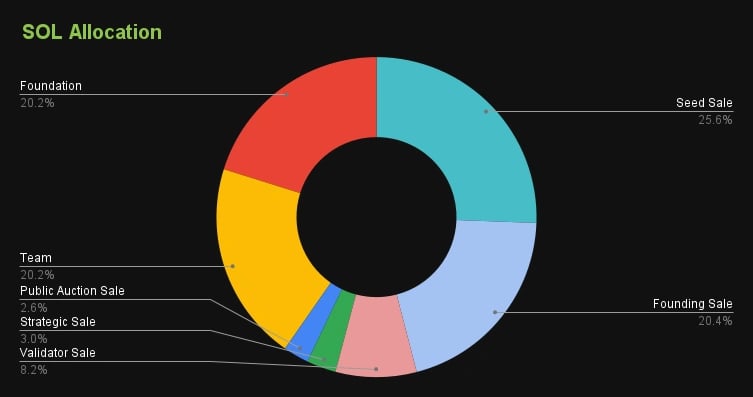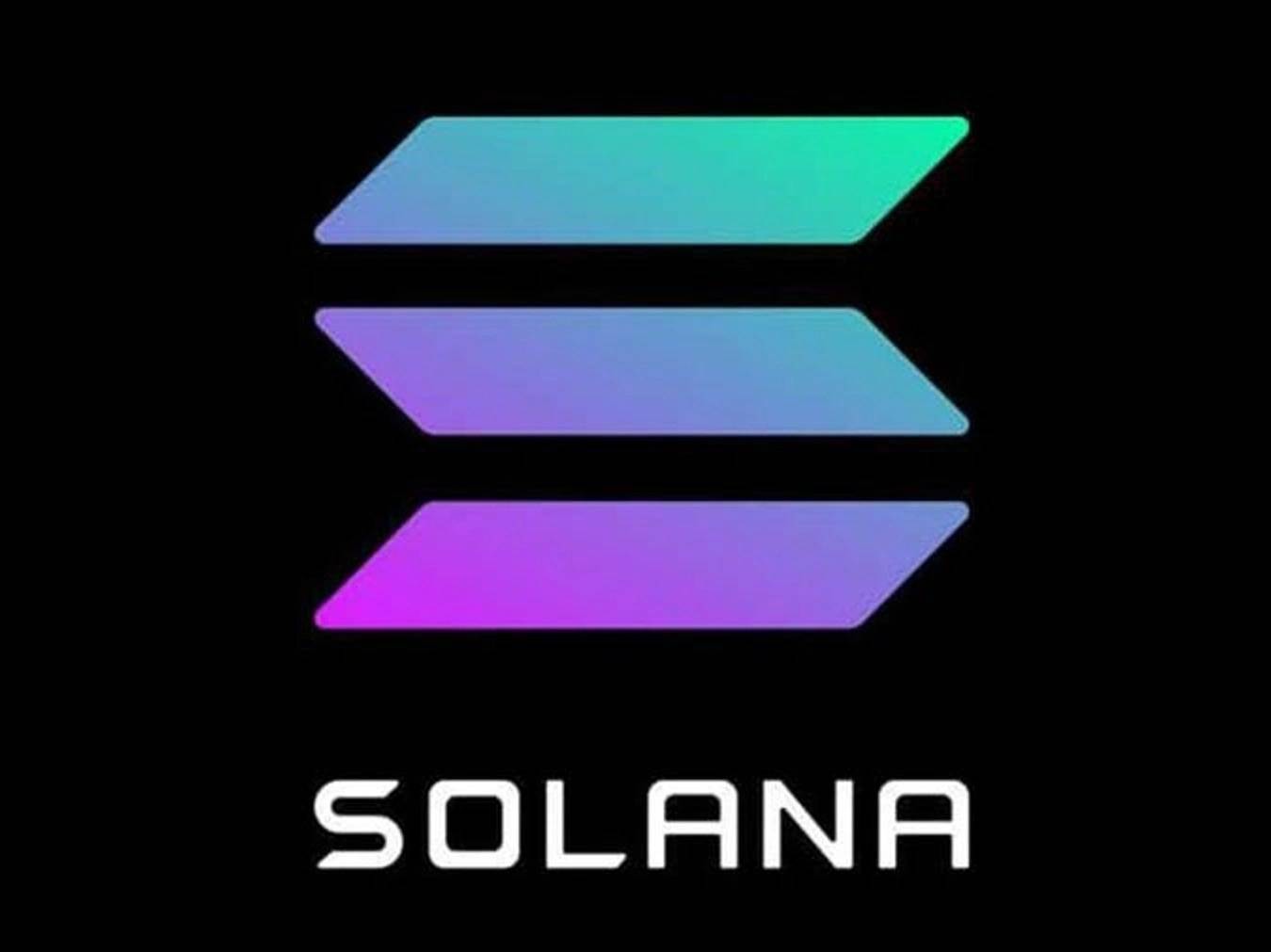위키 구독하기
Share wiki
Bookmark
Solana (SOL)
Solana (SOL)
SOL은 스마트 계약과 dApp(분산 애플리케이션)을 지원하는 레이어 1 블록체인인 솔라나의 네이티브 암호화폐입니다. 사용자는 노드 또는 검증자가 되어 네트워크에 기여함으로써 SOL을 얻을 수 있습니다. 이 네트워크는 토큰 공급을 줄이기 위한 수단으로 SOL 토큰을 소각하는 디플레이션 모델을 따릅니다.
솔라나는 이더리움의 ERC-20과 유사한 토큰 표준으로 SPL 프로토콜을 사용합니다. [1][7]
토큰 할당
SOL의 초기 분배는 다음과 같습니다. 시드 세일이 15.86%로 가장 높은 비율을 차지했으며, 창립 세일이 12.63%, 검증자 세일이 5.07%를 차지했습니다.
전략적 세일은 1.84%, 공개 경매 세일은 1.60%를 차지했습니다. 팀과 재단은 각각 12.50%를 할당받았으며, 커뮤니티 준비금은 38.00%로 가장 높은 비율을 차지했습니다. [1]

인플레이션
2023년 현재 솔라나의 연간 인플레이션율은 6.325%이며, 매년 15%씩 감소할 예정입니다. 이 인플레이션율은 약 180 에포크에 걸친 '에포크 연도'를 기준으로 합니다. 에포크의 길이는 네트워크 성능에 따라 약 2.5일에서 3.5일까지 다양하며, 실제 인플레이션율의 변동을 초래합니다. [8]
스테이킹 연간 수익률(APY)이 인플레이션율보다 높은 주된 이유는 두 가지입니다. 첫째, APY는 일 년 동안 스테이킹 계정에 보유된 SOL의 복리 효과를 고려합니다. 둘째, 비스테이커는 네트워크 보안을 위해 스테이킹에 참여하는 스테이커에게 보상합니다. [8]
인플레이션율을 상쇄하기 위해 거래 수수료가 역할을 합니다. 구체적으로, 모든 거래 수수료의 50%는 소각되어 SOL 공급량이 줄어들고, 나머지 50%는 거래를 처리한 검증자에게 '블록 보상'으로 할당됩니다. 시간이 지남에 따라 거래 수수료의 양이 증가하여 스테이킹 보상 감소에 대한 검증자의 보상을 제공할 것으로 예상됩니다. [8]
자금 조달
2019년에는 세 차례의 사모 투자가 이루어져 Multicoin Capital, BlockTower Capital, Rockaway Ventures와 같은 투자자들로부터 2,000만 달러의 자금을 확보했습니다.
이러한 사모 투자 중에 판매된 토큰 수는 공개되지 않았습니다. 공식 성명에 따르면 조달된 자금은 엔지니어링 및 프로젝트 관리에 할당되었습니다. [2]
2020년에는 CoinList에서 공개 경매를 통해 400만 달러를 조달했습니다. [2]
ICO(Initial Coin Offering)는 2020년 3월 16일부터 3월 24일까지 진행되어 총 2,500만 달러가 조달되었습니다. [5]
솔라나는 11라운드에 걸쳐 총 3억 1,580만 달러의 자금을 조달했습니다. 최근 자금 조달은 2021년 8월 19일에 기업 라운드를 통해 이루어졌습니다. [9]
유틸리티
SOL은 솔라나 블록체인의 네이티브 토큰입니다. 거래를 보낼 때 또는 스마트 계약과 상호 작용할 때 거래 수수료(가스비)를 지불하는 데 사용할 수 있습니다.
또한 스테이킹을 통해 네트워크를 보호하는 데에도 사용할 수 있습니다. 사용자는 자신의 SOL을 직접 스테이킹하거나 보상의 일부를 받는 대가로 활성 검증자에게 자신의 자산을 위임할 수 있습니다. [7] [1]
스테이킹
솔라나 블록체인은 네트워크를 보호하고 체인의 새로운 블록을 검증하기 위해 지분 증명(Proof-of-Stake) 메커니즘을 사용합니다. 사용자가 이 프로세스의 일환으로 SOL 토큰을 스테이킹하면 새로 발행된 SOL 보상을 받습니다. [2][3][4]
스테이킹 프로세스는 거래를 처리하고 네트워크를 유지 관리하는 검증자에게 토큰을 위임하는 것을 포함합니다. 이 모델은 토큰 보유자와 검증자가 함께 협력하고 위험과 보상을 공유하도록 장려합니다.
검증자는 더 많은 스테이크를 받을수록 더 많은 보상을 받을 수 있으며, 더 낮은 수수료를 제공하여 더 많은 스테이크를 유치함으로써 다른 검증자와 경쟁할 수 있습니다.
그러나 악의적인 행위에 대한 대응으로 검증자의 위임된 스테이크의 일부가 제거되는 슬래싱을 통해 토큰을 잃을 위험이 있습니다. 검증자의 미래 보상 손실은 네트워크 보안 및 성능을 장려합니다. [6]
dApp
SOL은 분산 애플리케이션(DApp)을 포함한 모든 거래와 관련된 가스비를 지불하는 데 주로 사용됩니다.
ETH와 마찬가지로 SOL은 솔라나 생태계 내에서 주요 통화 역할을 하며, 개인이 다양한 상품과 서비스에 대한 비용을 지불할 수 있도록 합니다.
예를 들어, SOL은 Raydium과 같은 분산형 거래소의 거래 수수료를 지불하는 데 사용됩니다. [2][4]
잘못된 내용이 있나요?
